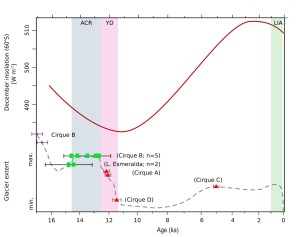Written by Ignacio Jara, Victoria University Wellington
Although the long-term changes in solar insolation between Northern Hemisphere (NH) and the Southern Hemisphere (SH) are in anti-phase, marine and ice core records from both hemispheres show highly synchronous glacial/interglacial cycles over the last 800 kyr. This disparity between the insolation and the paleo-records is probably the most important caveat concerning Milankovitch’s theory of orbital parameters controlling Earth’s climate. Particularly puzzling for the SH is that glacial/interglacial transitions follow the NH summer insolation, and therefore deglaciations in southern latitudes occur under decreasing local summer insolation1. In order to resolve this apparent conflict it is necessary to develop new detailed glacial chronologies which are able to be compared with other glacial and climate reconstructions from both hemispheres.
Southern South America has the most extensive ice sheets of the Southern Hemisphere outside of Antarctica, and thus it is not surprising this area boasts outstanding geomorphologic evidence of late Quaternary glacial fluctuations. Yet, the timing of these fluctuations has remained more or less equivocal until recently. Two newly-published glacial reconstructions from this part of the world provide new interesting insights into this topic.
Firstly, a detailed geomorphological map of the Torres del Paine area (51°S) has been produced. This is a region with extensive glaciers and massive moraine belts extending up to 35 km from present-day ice margins2. The boulder exposure 10Be dates indicate a major glacial advance culminating at 14,200 cal yr BP, while basal 14C dates from peat sections embedded in the moraine complexes indicate that ice sheet remained extended until 12,500 cal yr BP.
This chronology is supported by a more recent publication of surface exposure and radiocarbon ages from moraine complexes in Tierra de Fuego (54°S), the southern-most tip of South America and a region whose geomorphology was previously poorly mapped and dated3. The authors attribute the lack of early-Holocene moraines as evidence for dry and warm conditions during this period and suggest that the glaciers may have reached near present-day positions as early as 11,200 cal yr BP.
Overall, these two reconstructions show clear evidence for a net glacial retreat between 16,000-11,000 cal yr BP, a period of decreasing SH summer insolation. Likewise, the Tierra del Fuego reconstruction shows the absence of sustained glacial retreat during the Holocene, a period of increasing summer SH insolation. Hence, these studies are consistent with the orbital/climate paradox, suggesting that the SH summer insolation does not control (at least not directly) the ice fluctuations on the Southern American continent.
So what caused this change?
Apart from the NH summer insolation, it has been argued that other orbital parameters such as the SH summer duration and SH spring insolation could be important drivers1. The remarkable detail in the glacial reconstructions presented in these two publications may provide other clues. The ice advances during the Antarctic Cold Reversal (ACR; 14,500-12,900 cal yr BP) are observed at both the Torres del Paine and Tierra del Fuego regions, suggesting a strong Antarctic influence. Moreover, ACR glacial advances have also been recorded in the Southern Alps of New Zealand4, suggesting a zonally synchronous response across the SH, which may point to the Southern Westerly Winds and/or the Southern Ocean as important players.
Taken together, these recent publications are important contributions to better constrain the timing and forces affecting the SH glacial history over the last 16,000 years. They also highlight the potential of Southern South America for glacial reconstructions, and show the importance of glacial geomorphology studies for late Quaternary global climate reconstructions.
Glacial retreat between 16,000-11,000 cal yr BP in Tierra del Fuego occurs under decreasing Southern Hemisphere summer insolation. ACR, YD and LIA denote Antarctic Cold Reversal, Younger Dryas and the Little Ice Age respectively. Pink circles and green squares indicate 10Be dates, while red triangles indicate radiocarbon dates from the different sites from Menounos et al. (2013).
References
1. Huybers, P. & Denton, G. Antarctic temperature at orbital timescales controlled by local summer duration. Nature Geosci 1, 787-792 (2008).
2. García, J.L., et al. Glacier expansion in southern Patagonia throughout the Antarctic cold reversal. Geology 40, 859-862 (2012).
3. Menounos, B., et al. Latest Pleistocene and Holocene glacier fluctuations in southernmost Tierra del Fuego, Argentina. Quaternary Science Reviews 77, 70-79 (2013).
4. Putnam, A.E., et al. Glacier advance in southern middle-latitudes during the Antarctic Cold Reversal. Nature Geosci 3, 700-704 (2010).
